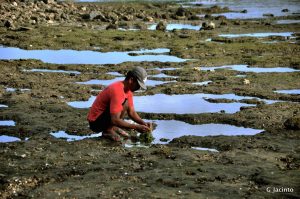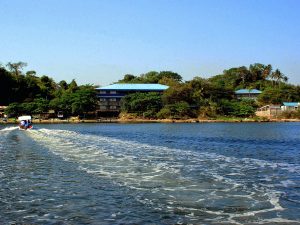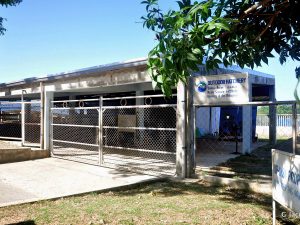THE BML COMPLEX
The facility has a 5-hectare complex that includes the following buildings below.
The facility has a 5-hectare complex that includes the following buildings below.

The project-based and communal labs are located at the main laboratory building. There is an algal culture room used regularly for the culture of micro-algae as food for larvae and juveniles of marine organisms that is being reared in the hatchery. Communal equipment like ovens, freezers, refrigerators, and autoclaves are placed at the Hot and Cold room in the second floor of the building. There are also communal equipment placed in the two Instrument rooms at the first and second floor such as stereo, compound, inverted and epiflourescence microscopes, analytical balances, microtomes, multi-parameters, centrifuges. are located at the Instrument room. Researchers are required to fill out the log books provided, before and after use, aside from the reservation form that they need to accomplish. Audio visual room, seminar room, classrooms and view deck serves as a venue for summer classes, trainings and workshops conducted at BML. A recreational area at the back of the main laboratory building is also used for BML official parties. Beside it is a Wet Lab used as an extension lab for researchers working with water and sediment samples, at the same time a venue for lab aides to work on their DIY setups.
A wet and dry museum on the 3rd floor of the main building houses special collections of giant clams and hard corals collected within the Bolinao-Anda Reef Complex and various sampling sites of MSI researchers around the Philippines. Highlighted in the collections of dry museum are the giant clam shells from Solomon Islands, one of the first broodstocks of the giant clams in Silaki Ocean Nursery; the largest Hippoppus hippopus in the world with shell length of 53.9 cm and the Hippopus hippopous giant clam shell with a pearl from the Silaki Ocean Nursery. The wet museum, established in 2012 with the help of some local interns, consists of pelagic and deep sea fish collections from various sampling sites in the Philippines. The collections are properly stored in ethanol solution. Visitors from different institutions are being toured at the BML museum before the COVID-19 pandemic. Occasionally, some collections are also brought in exhibit areas where BML is requested to present.

The BML maintains a dive locker which houses a compressor room, two shower rooms with locker facilities (male and female), a central rinsing area, and a locker compartments for the storage of diving equipment. Individual users under the various MSI projects which have Bolinao-based activities are awarded specific assignments. There exists a compressor room, where two (2) compressor units are used alternately: (one which is diesel-powered, and a second one run by electricity). Approximately 50 scuba tanks for rental are filled and stored in the compressor room, to be readily used for fieldwork.

The admin building houses the multi-purpose hall, library, admin office and cafeteria. The Multi-purpose hall located at the 2nd floor of the Administration Building serves as a venue for trainings, lectures and workshops held at BML. Books, journals, training manuals, photographs, brochures and other research materials are available in the library located beside the administration office where the admin officer, institutional research assistant and the admin aide works. The Office of the DDML is also located beside the library. The BML Cafeteria is also located at the 2nd floor of the Administration building.

The BML has two (2) dormitories for student and BML-based researchers, each with a 40-bed capacity, communal toilet and bath, communal kitchen, and laundry facilities. For the Senior Researchers, the BML have one single detached housing unit with 2 bedrooms, toilet and bath and living room, dining and kitchen and three duplex units, each with 2 bedrooms, toilet and bath, living room, dining and kitchen, and with basements (4 units) converted into studio type housing units.

The hatchery is a major research facility at BML and is approximately 1,400-sqm in land area. Currently, it is equipped with five (5) seawater pumping systems for continuous seawater supply in the tanks and four (4) aeration systems. Seawater is being sourced from a depth of 10 m at a distance of 200 m from the shore. Sedimentation and filtration treatments of raw seawater were conducted prior to use in different culture set-ups. There are several sections of the hatchery assigned to different projects and organisms being cultured. The hatchery is the facility where culture of various commercially and ecologically important marine organisms is being conducted.
Currently, sea cucumbers, corals, seaweeds, and giant clams are cultured at the BML hatchery. The hatchery houses a small algal culture facility, temperature controlled-room for manipulative experiments and mass flow system for ocean-acidification experiments. There are two BML personnel holding permanent UP items (Foreman Electrician and Electrician II) who are in-charge of the hatchery operations in terms of infrastructure maintenance. Routine maintenance at the hatchery (e.g., cleaning of sedimentation/filtration tank) is also being done through the services of laborers hired by BML. Overall supervision of hatchery operations is part of the task of the Deputy Director for Bolinao Marine Laboratory, with administrative support from the BML Administrative Officer (both holding permanent UP positions), BML Institutional Research Assistant (Temporary) and Administrative Aide (Permanent). Occasional tours are being conducted in the hatchery before the pandemic.”